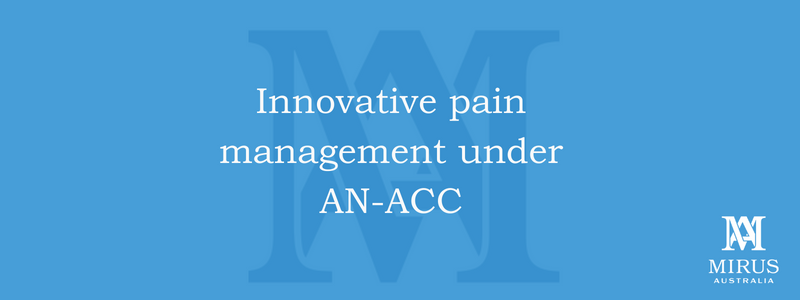Innovative pain management under AN-ACC
October 4, 2022 | AN-ACC

By Taranjot Minhas, Consultant
With the introduction of the AN-ACC funding model for residential aged care, there are many key issues that aged care providers need to address. One of these is pain management as there is no specific pain management claim under the AN-ACC model and this is now incorporated into the increased funding assigned to the classifications. In addition, allied health staff are not included in the care minutes requirement – which only includes RN, EN and Care Worker/AIN.
But effective pain management continues to be a requirement in both the ACFI and AN-ACC worlds and will still be covered by The Aged Care Quality Standards.
We monitor more than 80,000 residents through our Benchmarking and Insights solution and have been leading 50+ organisations through the change management process of the transition to AN-ACC funding model.
In guiding our clients through transitioning pain management at their facilities, we have realised five key steps that can be taken to transition your 4B pain management program into the ANACC world:
1. Identify
Analyse care information to identify potentially suitable candidates to remove from 4B onto an alternative, taking care to accurately review the residents’ current pain levels and efficacy of the pain management options currently provided, in line with Standard 2 of the Aged Care Quality Standards. To remove the 4B treatment without an understanding or monitoring the implications for the resident opens the door to poor care outcomes and complaints.
2. Case conferencing
Discussion with care staff and allied health teams regarding the resident and their suitability for other pain management.
3. Tracking
Managing the transition of residents from 4B onto alternative solutions.
4. Innovation
Trial of alternative methods of pain management.
5. Compliance
Circle back after 2-3 months to check care information to ensure pain is being managed and nothing has been missed from safety and quality perspectives.
While working with our clients we’ve heard different providers offering different services and pain management options for their residents based on their staff’s skillsets, resources and geographies, resident demographics and facilities’ readiness for change. There are so many options other than massage that can effectively manage pain that we’ve compiled the below list with resources linked, so you can guide your own organisations through this process as well.
- Walking groups around facility and outside
- Strength-based or balance-based group exercises – to reenable residents and reduce falls incidences, which could inspired by the SUNBEAM Trial or the HIFE Program
- The GrACE Program – research published by Bond University in 2016 found just twice weekly resistance exercises improved gait speed, sit to stand performance, and grip strength:
The GrACE Programme, consisting of progressive weight bearing combined with resistance training, was shown to be feasible, sage and effective in improving muscle function in RAC residents…
Our findings addressed a number of previously unanswered and understudied questions in relation to the feasibility, safety and benefits of exercise classes that could be offered by RAC facilities to their residents. By having a greater understanding of these issues, RAC providers can better target interventions (e.g. exercise for maintaining gait speed or to reduce falls risk) to their residents.
- Diagnosis specific classes e.g., for those diagnosed with a stroke or Parkinson’s Disease, if you have a significant number of residents affected by these
- Seated yoga and tai-chi classes – for those who could only do gentle movements while still targeting falls and pain.
- Music therapy – for those with lower cognitive abilities or Parkinson’s Disease which respond well to a beat, like to get groovy or find it helpful to reminisce.
- Dance classes – another moment for improved mood and displaying their moves while also sneaking in some balance and coordination exercises.
- Hydrotherapy either in the facility or a local pool.
- Sensory rooms – designed to engage different cognitive abilities.
- Meditation sessions – to assist in managing chronic pain, and improve quality of life.
- Distractions/redirection through social engagements e.g., leisure and lifestyle events and community events
- Quiet rooms – to silence outside voices and ground the resident.
Some of our clients have shared that they were encouraged by ABC’s program, Old People’s Home For 4 Year Olds, and collaborated with the childcare centre or playgroups near their facility to coordinate days where the 80-90 year age gap closes for a few hours of activities and bonding.
Traditional therapies like reflexology, acupressure, wax baths and aromatherapy may be worth considering as well. And of course, the usual heat packs, TENS machines, medication reviews and repositioning are still in our toolbox to be pulled out where needed.
I hope this blog sparks some ideas and you can recognise potential alternatives that your organisations can offer for residents’ pain management. Of course, if you have any questions or concerns about managing the transition to AN-ACC, please reach out to one of our team.


